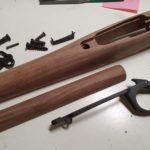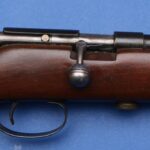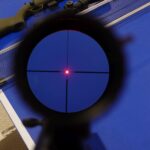Well, the somewhat boring answer is that they’re all pretty good. Firearms media and old timers love to talk up their favorite cartridges, but pretty much any of the popular hunting cartridges perform ballistically and on-game very much alike. I’m also assuming Deer, Elk, and Moose are the intended game; this isn’t the article you want for selecting a Safari rifle or varmint buster.
Comparable Attributes
Recoil
I think one of the more important attributes to think about with cartridge selection is recoil. Simply put, you can get more range, velocity, and impact power by going up, but bigger isn’t always better. A hard recoiling rifle will give some shooters an accuracy-ruining flinch. A hard recoiling rifle will also be less fun to shoot at the range, which could stop some people from practicing and getting good with their rifle. And hard recoiling rifles can even turn some people off hunting. If you’ve shot hard-recoiling rifles and can shoot them accurately, fill your boots with a 300 win mag or WSM. Both of those cartridges will do the job on deer through Elk at great distance.
Cost
Ammo cost when you’re talking about hunting large game shouldn’t be a big deal. The most you’re going to pay for a box of common hunting rounds is ~$50, which is marginal compared with other costs related to a hunt like gas, food, guide fees, time off work, etc. That said, “standard” cartridges like the 308, 30-06, 270, and the like are usually fairly inexpensive, while newer or less popular cartridges are pricier. It’s easy to get 20 rounds of 30-06 for $25, but pretty much impossible for 300 WSM. If you reload, brass usually costs much more for newer rounds, and larger capacity rounds will use more smokeless powder. You can also get once fired brass inexpensively for popular rounds.
Availability
If you forgot to bring your ammo hunting, you were miles away from any major city and the only place nearby was a small fishing shop, how likely would it be that you could find some ammo for your rifle? If you have a 30-06, 270, or 308, odds are pretty good. If you have something less common like a 7mm-08, 25-06, any of the WSSMs, you’re probably out of luck. I’ve never forgot my ammo before, but this does keep me from getting anything too weird.
Ballistics
I’ve already covered much of the differences between popular hunting cartridges in this article, and the summary is that they’re all very similar, except the 30-30 which is pretty limited in range.
Larger Game
This is where I’m going to rule out a few of the cartridges. You can kill an Elk or Moose with some of these, but I wouldn’t recommend it.
I wouldn’t use any of these cartridges on a CXP3 animal:
- 223
- 243
- 25-06
- 30-30
I’m going to take some heat on including the 30-30 on the no-go list, but let’s be real for a minute: it sticks out as one of the most marginal, poorest performing cartridges still used to hunt large game. Yes, a Winchester 94 is a joy to carry in the woods, yes it reloads pretty quickly, and yes, it is fine for use within close range. But if that big Elk pokes its head out at 300 yards, the 30-30 will be doing you no favors in accuracy, ballistics, and lethality.
Best Deer cartridges: 243 for the recoil sensitive, 270, 308, or 7mm-08 for the rest. 7mm rem mag is great, but it doesn’t do anything a lot better, and it is more expensive. If cost isn’t a huge issue, the 270 WSM gives a bit more range and a slightly shorter action.
Best Elk/Moose cartridges: 308 or 30-06 do fine, but there’s always the 7mm rem mag and 300 win mag for those who want to strike a long ways out. 300 WSM and 270 WSM are good for reducing action length and still bringing big performance, which would be great if you’re doing a lot of hiking in and out to get to your spot and need a light rifle. It won’t be a joy to shoot a light, hard recoiling rifle, but sometimes compromises must be made.





